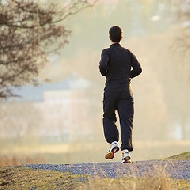Managing Knee Osteoarthritis for Runners
Posted by Alex Hetherington CP on March 26, 2013

The Starting Line:
For knee osteoarthritis, what can be done for the pain, and should you keep running?
Knee osteoarthritis (OA) is one of the most common musculoskeletal disorders, and a leading cause of knee pain and disability. It is characterized by the degeneration of articular cartilage at the knee joint. Knee OA more often affects the medial compartment (inside of knee) because of the greater load applied to this compartment (relative to the outside, or lateral) during walking and other weight-bearing activities. People diagnosed with knee OA often ask about pain control for running and other everyday activities.
Running does put additional demands and stress on the joints. While a number of studies suggest that a moderate level of physical activity does not cause permanent joint damage or a predisposition to OA, any abnormal joint stress can increase the progression of arthritis. This can be caused by running on an injured joint, poor biomechanics, or muscle weakness due to inadequate cross-training.
Unfortunately, there is no cure for knee OA. This means that relief of symptoms and minimization of disease progression are the major aims of most conservative treatments (surgery and knee arthroplasty are non-conservative approaches). Altering foot mechanics has been shown to affect forces at the knee and indirectly relieve pain associated with OA. Most literature suggests a 5° lateral wedge throughout the entire length of shoe insert can help relieve medial knee osteoarthritis by lightnening some of the load on that part of the knee.
Hinman et al. analyzed the gait of 73 subjects and found a significant reduction in peak knee adduction moments (a surrogate measure for the loading across the medial knee joint) in trials with a lateral wedge. A close look at the data suggests that this reduction was created by influencing the ground reaction force in relation to the knee joint center. These findings were confirmed by Barrios et al., who evaluated knee mechanics in individuals with medial knee OA who wore laterally wedged orthoses over a 1 year period. Combined, these studies suggest a positive effect of the wedge intervention on knee osteoarthritis. However, it is important to note that this approach is only appropriate for people with medial OA and it may actually be worse for people with lateral joint OA, so be sure to consult with your healthcare provider before experimenting with any shoe inserts.
The Finish Line:
Altering foot mechanics may help reduce knee load and pain during everyday activity. However, the lateral wedge is not a substitute for proper running mechanics.
References:
Hinman RS, Bowles KA, Metcalf BB, Wrigley TV, Bennell KL. 2012. Lateral wedge insoles for medial knee osteoarthritis: Effects on lower limb frontal plane biomechanics. Clin Biomech (Bristol, Avon). 2012 Jan;27(1):27-33. doi: 10.1016/j.clinbiomech.2011.07.010. Epub 2011 Sep 8. http://www.ncbi.nlm.nih.gov/pubmed/21862189
Barrios JA, Butler RJ, Crenshaw JR, Royer TD, Davis IS. 2012. Mechanical effectiveness of lateral foot wedging in medial knee osteoarthritis after 1 year of wear.J Orthop Res. 2013 May;31(5):659-64. doi: 10.1002/jor.22252. Epub 2012 Oct 23. http://www.ncbi.nlm.nih.gov/pubmed/23097326
Photo Credit: Ernst Vikne via photopin cc
*Note: This general information is not intended to be a substitute for medical treatment or advice. Always consult a professional before making changes to your health and wellness practices.
Feedback or suggestions for future topics? Let us know!
